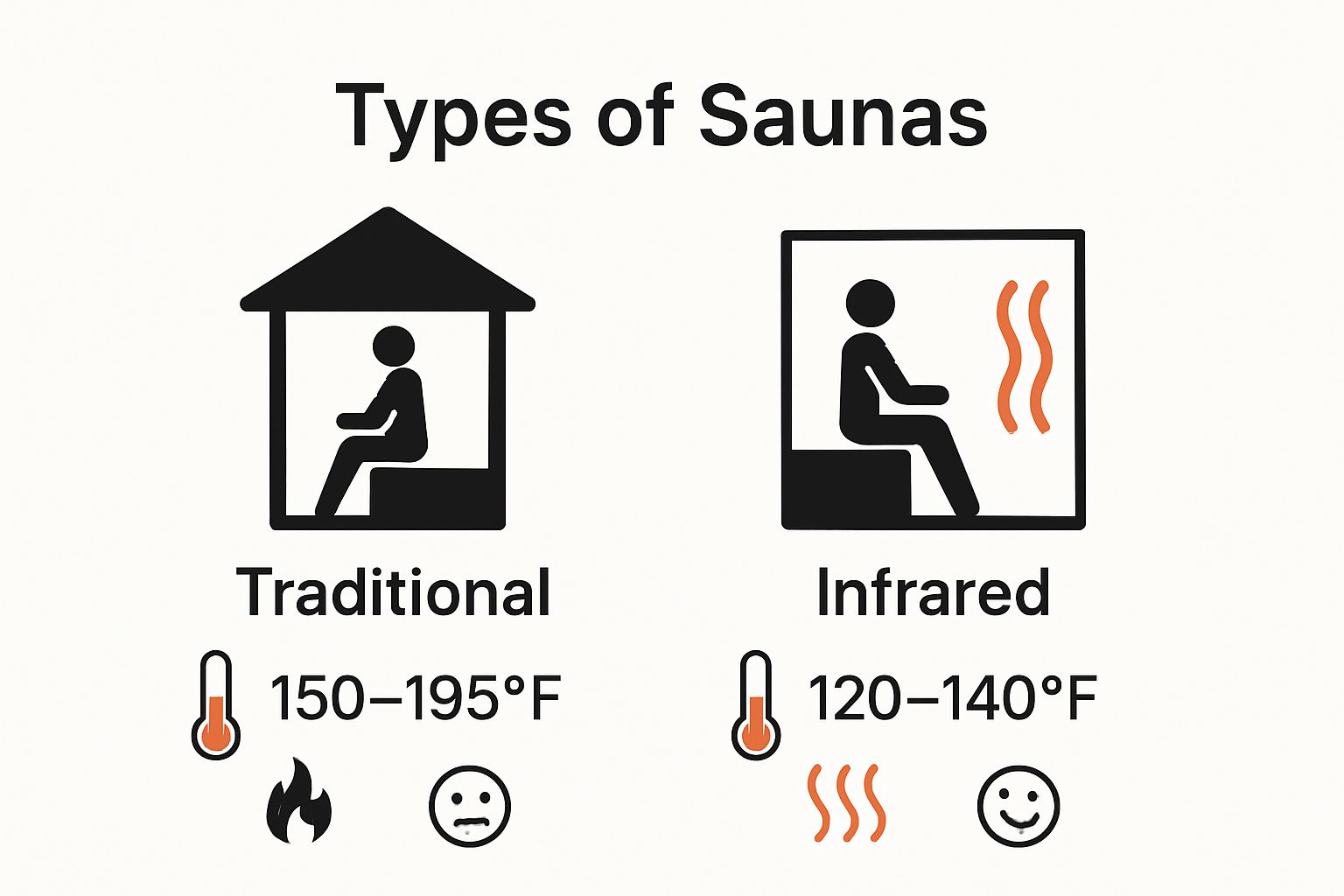
Understanding Your Buying Sauna Guide for Wellness
A sauna is more than just a warm room for relaxation. Traditional saunas can reach up to 195 degrees Fahrenheit, making them hotter than most summer days in Death Valley. Surprising right? That intense heat is not just about sweating. It actually sets off a chain reaction inside your body that mimics the benefits of a light workout and can even support better brain health. Get ready to rethink what happens every time you step into those steamy wooden walls.
Table of Contents
- What Is A Sauna And How Does It Work?
- Why Saunas Are Essential For Health And Relaxation
- Different Types Of Saunas: Which One Is Right For You?
- Key Features To Consider When Buying A Sauna
- Integrating A Sauna Into Your Home: Benefits And Tips
Quick Summary
| Takeaway | Explanation |
|---|---|
| Saunas promote relaxation and wellness. | Saunas create a heated environment that enhances relaxation and supports overall health through thermal stress. |
| Regular sauna use boosts cardiovascular health. | Sauna sessions can mimic moderate exercise by increasing heart rate and improving circulation, benefiting cardiovascular efficiency. |
| Infrared saunas provide targeted heat therapy. | Infrared saunas use light waves to directly heat body tissues at lower temperatures, making them suitable for sensitive users. |
| Saunas aid in mental health and stress reduction. | The therapeutic heat helps release endorphins and may improve emotional regulation, contributing to mental wellness. |
| Careful selection is crucial when buying a sauna. | Consider size, heating technology, and installation requirements to ensure the sauna aligns with health goals and home configurations. |
What is a Sauna and How Does It Work?
A sauna represents a specialized heated room designed to promote relaxation, wellness, and therapeutic heat exposure. These unique spaces create an environment where individuals experience high temperatures that trigger profound physiological responses within the human body. Research from the National Institutes of Health suggests that saunas are not just recreational spaces but powerful wellness tools with multiple health benefits.
Types of Sauna Heating Systems
Saunas operate through different heating mechanisms, each offering unique characteristics and experiences. The three primary heating systems include:
- Traditional wood-burning saunas that use heated rocks to generate intense dry heat
- Electric saunas with precise temperature controls and consistent heating elements
- Infrared saunas utilizing specialized light waves to directly warm body tissues
Traditional saunas typically reach temperatures between 150 to 195 degrees Fahrenheit, creating an environment that induces sweating and promotes relaxation. The heating process involves warming the air and surrounding surfaces, which then transfer heat to the human body through convection and radiation.
Physiological Responses to Sauna Heat
When exposed to high temperatures, the human body initiates a series of complex physiological reactions. Blood vessels dilate, increasing circulation and promoting cardiovascular efficiency. Metabolic rates temporarily increase, and the body begins sweating as a natural cooling mechanism. These responses mimic light cardiovascular exercise, potentially offering benefits similar to moderate physical activity.
The thermal stress experienced in a sauna triggers the production of heat shock proteins, which help protect cells and potentially support overall cellular health. Additionally, the controlled heat environment can help reduce muscle tension, support immune function, and potentially improve skin health through enhanced circulation and detoxification processes.
Ultimately, understanding saunas goes beyond their physical structure. They represent a holistic wellness practice that leverages controlled heat exposure to support physical and mental well-being, transforming a simple heated room into a powerful tool for personal health optimization.
Why Saunas are Essential for Health and Relaxation
Saunas represent more than just a luxurious experience they are powerful wellness tools that deliver comprehensive health benefits. Research from the National Institutes of Health demonstrates that regular sauna use can significantly impact physical and mental well-being, transforming a simple heat exposure into a holistic health intervention.
Cardiovascular and Metabolic Benefits
Regular sauna sessions provide substantial cardiovascular advantages that extend far beyond basic relaxation. The intense heat environment triggers physiological responses similar to moderate exercise, creating unique health improvements. When exposed to high temperatures, the body experiences:
- Increased heart rate and improved blood circulation
- Enhanced cardiovascular performance similar to light aerobic activity
- Potential reduction in blood pressure and improved arterial flexibility
These cardiovascular adaptations suggest that sauna bathing could serve as an effective complementary practice for individuals seeking alternative fitness and wellness strategies. The thermal stress experienced during sauna sessions stimulates metabolic processes, potentially supporting weight management and overall metabolic health.
Mental Health and Stress Reduction
Beyond physical benefits, saunas play a critical role in mental wellness and stress management. The combination of heat, isolation, and deliberate relaxation creates a powerful environment for psychological recovery. The controlled thermal environment helps release endorphins, the body’s natural mood elevators, which contribute to reduced stress and improved emotional regulation.
The neurological impact of sauna use extends to potential long-term cognitive benefits. Studies suggest that regular sauna sessions might help reduce the risk of neurodegenerative conditions and support overall brain health. The heat induced stress response appears to trigger protective mechanisms within the brain, potentially enhancing neuroplasticity and cognitive resilience.
Ultimately, saunas represent a multifaceted wellness tool that addresses physical, mental, and emotional health simultaneously. By integrating controlled heat exposure into wellness routines, individuals can unlock a comprehensive approach to personal health optimization.
Different Types of Saunas: Which One is Right for You?
Choosing the right sauna involves understanding the unique characteristics and benefits of various heating technologies. Research from the Mayo Clinic highlights the importance of selecting a sauna that matches individual health goals and personal preferences.
Traditional Finnish Saunas
Traditional Finnish saunas represent the classic sauna experience, originating from centuries-old Nordic wellness practices. These saunas are characterized by:
- Dry heat environments with temperatures ranging from 150 to 195 degrees Fahrenheit
- Wood-burning or electric stoves that heat rocks to create intense thermal exposure
- Ability to create steam by pouring water over heated rocks
- Cultural significance as a social and therapeutic wellness practice
Traditional saunas offer an authentic experience that closely mimics the original Finnish wellness tradition. The intense dry heat provides a powerful thermal stimulus that promotes sweating, circulation, and overall bodily detoxification.

Infrared Saunas: Modern Wellness Technology
Infrared saunas represent a contemporary approach to heat therapy, utilizing specialized light waves to directly warm body tissues. Unlike traditional saunas that heat the surrounding air, infrared technology penetrates deeper into the body, creating a unique therapeutic experience. These saunas operate at lower ambient temperatures typically between 110 to 135 degrees Fahrenheit, making them more accessible for individuals who find traditional high-heat environments challenging.
The key distinction of infrared saunas lies in their ability to generate heat directly within body tissues. This targeted approach potentially offers more efficient metabolic stimulation and deeper cellular level benefits. Individuals seeking gentle, consistent heat exposure often find infrared saunas more comfortable and adaptable to their personal wellness needs.
To help clarify the differences between traditional Finnish saunas and infrared saunas discussed above, here is a comparison of their key features, benefits, and user experience.
| Sauna Type | Heat Source | Typical Temperature Range | Main Benefits | User Experience |
|---|---|---|---|---|
| Traditional Finnish | Wood-burning or electric | 150-195°F | Intense sweating, circulation, detoxification | Classic, social, dry or steam options |
| Infrared | Infrared light panels | 110-135°F | Deep tissue heat, efficient energy use, comfort | Gentler, direct heat, modern wellness |
Ultimately, selecting the right sauna depends on individual health objectives, personal comfort preferences, and specific wellness goals. By understanding the unique characteristics of different sauna types, individuals can make informed decisions that align with their physical and mental health requirements.
Key Features to Consider When Buying a Sauna
Purchasing a sauna represents a significant investment in personal wellness that requires careful consideration of multiple factors. Research from the North American Sauna Society emphasizes the importance of understanding critical features that impact overall sauna performance and user experience.
Size and Installation Requirements
Selecting the appropriate sauna size involves evaluating personal space, intended usage, and specific home configuration. Critical considerations include:
- Available square footage for sauna installation
- Number of potential users simultaneously
- Indoor versus outdoor placement considerations
- Electrical infrastructure and potential renovation needs
Home saunas range from compact single-person units to expansive multi-person configurations. Understanding spatial constraints and electrical requirements becomes crucial in making an informed purchasing decision. Potential buyers must carefully measure designated installation areas and confirm compatibility with existing home infrastructure.
Heating Technology and Energy Efficiency
The heating mechanism represents a fundamental aspect of sauna selection, directly influencing performance, operational costs, and therapeutic effectiveness. Different heating technologies offer unique advantages:
- Traditional electric heaters providing consistent thermal distribution
- Infrared panels offering targeted, energy-efficient heat penetration
- Wood-burning options delivering authentic thermal experiences
- Hybrid systems combining multiple heating technologies
Energy efficiency emerges as a critical consideration, with modern sauna designs prioritizing reduced electricity consumption and sustainable operational models. Advanced heating systems now incorporate sophisticated temperature controls and insulation technologies that minimize energy waste while maintaining optimal thermal performance.
Ultimately, selecting the right sauna transcends simple aesthetic preferences. Buyers must conduct comprehensive evaluations that balance personal wellness goals, spatial constraints, technological capabilities, and long-term investment potential. A strategic approach to sauna selection ensures a harmonious integration of health technology into personal wellness routines.

Integrating a Sauna into Your Home: Benefits and Tips
Transforming your living space to include a personal sauna requires strategic planning and thoughtful consideration of both design and functional requirements. Research from the Architectural Digest suggests that successful home sauna integration goes beyond simple installation, involving comprehensive lifestyle and wellness planning.
Spatial Planning and Design Considerations
Effective sauna integration demands careful evaluation of available home spaces and potential configuration options. Homeowners must consider multiple strategic placement scenarios:
- Indoor bathroom or spa areas with dedicated wellness zones
- Basement or lower-level recreational spaces
- Outdoor deck or garden environments with appropriate structural support
- Dedicated wellness rooms with climate control capabilities
The optimal location balances accessibility, privacy, and thermal performance. Proximity to shower facilities, adequate ventilation, and moisture-resistant surfaces become crucial factors in creating a functional and enjoyable sauna environment. Professional consultation can help identify the most suitable installation approach based on individual home characteristics.
Electrical and Structural Preparedness
Successful sauna integration requires comprehensive electrical and structural assessment. Modern saunas demand specialized electrical configurations and robust infrastructure to ensure safe and efficient operation. Key preparedness considerations include:
- Dedicated electrical circuits with appropriate amperage
- Professional electrical wiring and grounding systems
- Moisture-resistant flooring and wall treatments
- Proper insulation and vapor barrier installations
- Compliance with local building codes and safety regulations
Homeowners should engage licensed electricians and contractors experienced in sauna installations to guarantee proper implementation. Professional expertise helps mitigate potential safety risks and ensures optimal performance of the sauna system.
The following table organizes important considerations and features to evaluate when selecting and installing a sauna, making it easier to review critical points at a glance.
| Feature/Consideration | Details |
|---|---|
| Size | Matches space available; ranges from single to multi-person |
| Installation Requirements | Space, electrical setup, possible renovations |
| Heating Technology | Electric, infrared, wood-burning, or hybrid |
| Energy Efficiency | Modern saunas focus on reduced electricity use |
| Placement Options | Indoor (bathroom, basement), outdoor (deck, garden) |
| Structural Preparedness | Moisture-resistant floors/walls, insulation, building codes |
| Professional Support | Licensed electricians/contractors recommended |
Ultimately, integrating a sauna represents a holistic approach to personal wellness that extends beyond simple equipment installation. By carefully considering spatial dynamics, technological requirements, and individual lifestyle needs, homeowners can create transformative wellness spaces that enhance overall quality of life.
Transform Your Wellness Journey with the Right Sauna Choice
If you are feeling overwhelmed by the process of choosing the perfect sauna for your home, you are not alone. Many people struggle with selecting between traditional Finnish, infrared, and outdoor models, especially when considering installation and the health benefits noted in the article. Your desire to achieve stress relief, improved circulation, and total relaxation can feel complicated without trusted solutions that truly meet your wellness goals.
Discover a curated collection of premium saunas and accessories that make your decision easier. Explore top-rated saunas that are designed to fit every space and lifestyle with dedicated customer support every step of the way.

Ready to take the next step toward better health and relaxation? Visit Best Life Sauna today and shop with confidence, knowing you receive a price match guarantee, free shipping on orders over $200, and real support from wellness experts. Make your wellness vision a reality now while our exclusive offers last.
Frequently Asked Questions
What are the primary types of saunas available?
The primary types of saunas include traditional Finnish saunas, electric saunas, and infrared saunas. Each type offers different heating mechanisms and user experiences, tailored to individual preferences and wellness goals.
How do I choose the right sauna for my wellness needs?
Choosing the right sauna involves considering factors like the type of heating technology (traditional vs. infrared), size, installation requirements, and your specific health and wellness goals. Evaluate your preferences for heat intensity and how many users you expect to accommodate.
What are the health benefits of regular sauna use?
Regular sauna use can offer various health benefits, including improved cardiovascular performance, enhanced circulation, detoxification through sweating, and relaxation for mental well-being. It may also support metabolic health and aid in stress reduction.
What considerations should I take into account when installing a sauna at home?
When installing a sauna, consider factors such as available space, electrical requirements, and structural support. Ensure you allocate an appropriate area for installation, assess electrical needs, and address moisture-resistant finishes to create a safe and effective sauna environment.

